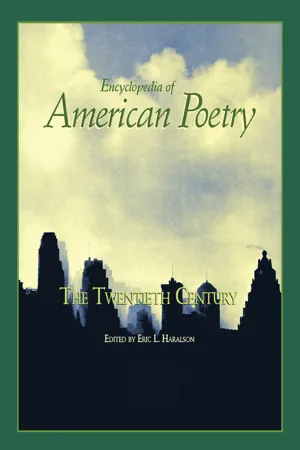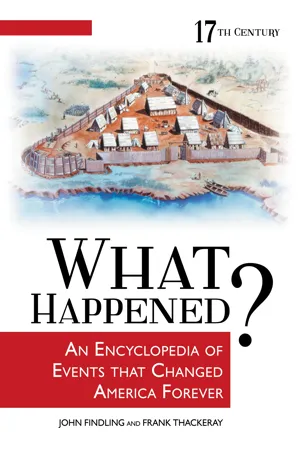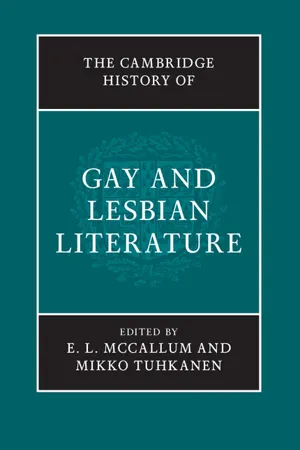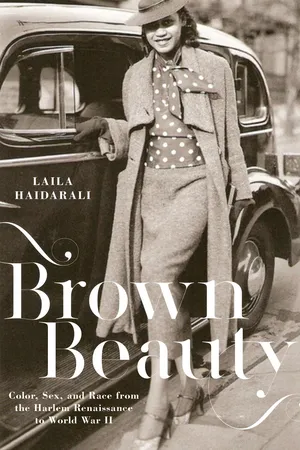History
Countee Cullen
Countee Cullen was a prominent African American poet during the Harlem Renaissance in the 1920s and 1930s. His work often explored themes of race, identity, and the African American experience, and he was known for his use of traditional poetic forms and lyrical language. Cullen's poetry contributed to the cultural and literary movement of the Harlem Renaissance, which celebrated African American art and culture.
Written by Perlego with AI-assistance
Related key terms
1 of 5
6 Key excerpts on "Countee Cullen"
- Margaret Perry(Author)
- 1970(Publication Date)
- Praeger(Publisher)
The reviews of this work will be considered in the next chapter. Throughout his lifetime Countee Cullen stressed the desire to be considered merely a poet, not a Negro poet. He once told a New York reporter: "I want to be known as a poet and not as a Negro poet. 32 This was especially true in the 1920s when, as Arna Bontemps once wrote: The Negroes' gifts were still departmentalized. There were poets in the United States, and there were Negro poets. There were musicians, and there were Negro musicians. There were painters, and there were Negro painters. Cullen abhorred this attitude. Almost his only public comments about the art in which he expressed himself were pleas for an evaluation of his work strictly on its merits, with- out racial considerations. He was to learn, however, that this was no small matter. 33 This was a conflicting matter never resolved, for although l 5 THE MAN AND HIS POETRY Cullen wished this to be the sentiment of both reader and critic, many of the themes of his poems are strictly racial. Even Cullen once said: "Most things I write I do for the sheer love of the music in them. Somehow I find my poetry of itself treating of the Negro, of his joys and his sorrows— mostly of the latter—and of the heights and depths of emotion I feel as a Negro." 34 His insistence on being thought of as quite simply a poet was by no means a pose or an excuse to shun the problems of the Negro in America, or to dissociate himself from any artistic endeavors made by his contemporaries. Following the Harlem riot of 1935, for example, Cullen was appointed and worked hard on a committee to investi- gate the riot and to suggest solutions for the situation. Harlem was, after all, his community—and he loved it.- Eric L. Haralson(Author)
- 2014(Publication Date)
- Routledge(Publisher)
One of the contributing causes of Cullen’s continuing neglect has been the importance given by black literary studies to black vernacular oral and literary traditions. His rejection of African-American expressive forms has earned him little favor among contemporary critics. Moreover, since Cullen wrote during the heyday of Modernism, he has not figured into contemporary reassessments of Modernism. Presently, except for Color, his books of poetry are out of print; selections of his poetry are anthologized. A NTHONY D AWAHARE See also Harlem Renaissance Biography Born Countee Leroy Porter in Louisville, Kentucky, 30 May 1903; adopted by Frederick Asbury Cullen, 1918. Attended New York University, B.A. 1925 (Phi Beta Kappa); Harvard University, Cambridge, Massachusetts, A.M. 1926; assistant editor and columnist, Opportunity magazine, 1927; taught French, Frederick Douglass Junior High School, New York, 1934–46. Received John Reed Memorial Prize (Poetry, Chicago), 1925; Spingarn Award (Crisis magazine), 1925; Harmon Foundation Literary Award, 1927; Guggenheim fellowship, 1928- eBook - PDF
Poets for Young Adults
Their Lives and Works
- Mary Loving Blanchard, Cara Falcetti(Authors)
- 2006(Publication Date)
- Greenwood(Publisher)
In addition, the James Weldon Johnson collection in the Beinecke Library at Yale University houses more than nine hundred letters and manuscripts written by, to, and about the poet. Websites “Perspectives in American Literature (PAL).” http://www.csustan.edu/english/ reuben/home.htm “Modern American Poetry: An Online Journal and Multimedia Companion to Anthology of Modern American Poetry.” http://www.english.uiuc.edu/maps/index.htm Poetry The Black Christ and Other Poems. New York: Harper & Bros., 1929. My Soul’s High Song: The Collected Writings of Countee Cullen. New York: Harper & Bros., 1947. 56 Countee Porter Cullen References and Suggested Reading Bontemps, Arna. The Harlem Renaissance Remembered. New York: Dodd, Mead, 1972. ———, ed. The Harlem Renaissance Remembered. New York: Dodd, Mead, 1972. Daniel, Walter C. “Countee Cullen as Literary Critic.” College Language Association Journal XIV (March 1972): pp. 281–90. Davis, Arthur. From the Dark Tower: African-American Writers 1900–1960. Washington, DC: Howard University Press, 1974. Davis, Arthur P. “The Alien-and-Exile Theme in Countee Cullen’s Racial Poems.” Phylon 14 (1953): pp. 390–400. Dorsey, David F. “Countee Cullen’s Use of Greek Mythology.” College Language Association Journal 13 (1970): pp. 68–77. Early, Gerald, ed. My Soul’s High Song: The Collected Writings of Countee Cullen, Voice of the Harlem Renaissance. New York: Doubleday, 1991. Kirby, David. “Countee Cullen’s Heritage: A Black Waste Land.” South Atlantic Bulletin 4 (1971): pp. 14–20. The Oxford Companion to African American Literature. New York: Oxford University Press, 1997. Perry, Margaret. A Bio-Bibliography of Countee P. Cullen, 1903–1946. Westport, CT: Greenwood Press, 1966. Rodgers, Marie E. The Harlem Renaissance: An Annotated Reference Guide. Englewood, CO: Libraries Unlimited, 1998. Wagner, Jean. Black Poets of the United States. Urbana: University of Illinois Press, 1973 (Part II). - eBook - PDF
- John E. Findling, Frank W. Thackeray, John E. Findling, Frank W. Thackeray(Authors)
- 2010(Publication Date)
- ABC-CLIO(Publisher)
Essays, poems, and short stories, frequently appearing in journals or periodicals such as DuBois’s The Crisis or Opportunity, edited by Charles S. Johnson, augmented a number of significant novels. A clarion call came from Claude McKay, a Jamaican immigrant who published “If We Must Die” in the July issue of The Liberator. In this seminal poem, McKay urged blacks to stand up and confront their oppressors, echoing the words of Mexican revo- lutionary Emiliano Zapata that “it is better to die upon your feet than to live upon your knees.” Another seminal moment occurred in with the publication of Howard Uni- versity professor Alain Locke’s The New Negro. In this work Locke trumpeted contem- porary African American achievements and hinted that the best was yet to come. Among the Harlem Renaissance’s black literati, sweetness and light did not always prevail. Much of the discord resulted from extreme egotism, a condition not unknown THE HARLEM RENAISSANCE, 1917–1935 55 to the general intellectual community. However, in the case of the Harlem Renaissance it also reflected a significant difference in cultural attitudes. At one end of the spectrum was Countee Cullen, the well-mannered, sensitive, one-time son-in-law of W. E. B. DuBois, who embraced “high culture.” For Cullen, it was much more important to be a poet than a Negro poet, and while he never ran from his race, his works were intended for the universal pantheon of literary greats. At the other end of the spectrum stood Langston Hughes, perhaps the most famous of the Harlem Renaissance writers. Hughes not only proclaimed his blackness, but he also embraced the common African American at the expense of the black elite. In his famous essay, “The Negro Artist and the Racial Mountain,” Hughes praised black cultural achievements as something unique, neither beholden to nor integrated with the white norm. - E. L. McCallum, Mikko Tuhkanen(Authors)
- 2014(Publication Date)
- Cambridge University Press(Publisher)
. searching . . . among black poppies and red calla lilies . . . he was searching pushed aside poppy stems . . and saw two strong white legs . . . dancer’s legs . . . the contours pleased him . . . (37; ellipses in original) While, at the end of “Smoke, Lilies and Jade,” the speaker expresses desire for a woman named Melva, he never recants his love for the male Beauty. Cobb writes that “the entire story is a collection of phrases divided by ellip- ses, calling to our attention, as most modernist works do, the form used to express a thought or a feeling, especially [those] that contradict literary convention” (344). 11 Regarded as the poet laureate by his Harlem Renaissance contemporaries, Countee Cullen has somewhat fallen out of critical favor, a judgment based primarily on the conventional romanticism of his verse, which was lampooned during the Harlem Renaissance by the prescient Wallace Thurman in his novel Infants of the Spring. 12 As Schwarz observes, Cullen chose to follow “writers like John Keats, Alfred Tennyson, and A.E. Housman” (48), rather than the jazz rhythms inspiring Hughes and Jean Toomer, or the modernist innova- tion championed by Hughes, Toomer, and Nugent. Attempting to maintain a respectable public persona, Cullen eschewed explicit sexual description. Expressing homoerotic feeling in code in his private correspondence, he is much more circumspect in his poetry, where we find desire scripted as het- erosexual or spelled out in gender-ambiguous terms. “Tableau,” from the 1925 collection Color, forms somewhat of an exception to this rule. While written Cole 394 with a structure of deniability, so that any implication of homosexuality can be denied, the poem celebrates the purity of an interracial, same-sex relation- ship.- eBook - ePub
Brown Beauty
Color, Sex, and Race from the Harlem Renaissance to World War II
- Laila Haidarali(Author)
- 2018(Publication Date)
- NYU Press(Publisher)
Saturday Evening Quill. Together, women’s poetry presents a textured compendium of the frustrations, expectations, and desires of middle-class New Negro women. Neither a collective movement nor an explicitly designed set of political expressions, this range of women’s verse showcases the use of color as a poetic device and as a descriptor of African American complexions. More acutely, the employment of color in women’s verse exposes some of the era’s contested gender politics, while emphasizing the role of complexion in general, and brownness in particular, in determinations of women’s beauty, social worth, and sexual respectability. This chapter is organized into two parts: first, it considers the women behind the words to offer biographies of these poets; second, it analyzes the poetry associated with middle-class notions of New Negro women with attention to the metaphoric use of brown. This popular mode illuminates the divide between women’s public physical personas and their creative attempts to reconcile subjective views of self from some of the aging prescriptions of New Negro womanhood. To put these two strands into fuller context, it is helpful to consider the unique importance of poetry in women’s cultural production of brownness within the larger context of Harlem’s literary and arts movement.“The Voice of My Own Experience”
Writing in 1972, Arna Bontemps, an African American male writer, reflected on the Harlem Renaissance and his role within the vibrant cultural movement. As he signaled certain key moments as marking its dawning and his “awakening,” Bontemps underlined the poem “Brown Boy to a Brown Girl” as one that “sounded like the voice of my own experience.” Reflecting on the poem written by Countee Cullen and published in Opportunity magazine in 1925, Bontemps explains, “I was enchanted.”3 Clearly, men also wrote and were moved by poetry and the use of brownness in poetry of the period; Bontemps’s reflection underlines its accessibility to readers across gender lines. This chapter focuses on women’s use of color descriptors, most notably brown and brown skin, to excise some of its unique meanings for and about New Negro womanhood.Poetry played a major role in the Harlem Renaissance’s commitment to representing the New Negro. Regularly featured in the major journals of the arts-based New Negro Renaissance, poetry was also showcased in the movement’s influential anthologies. Not surprisingly, these collections were assembled by African American men. Predating Locke’s New Negro, The Book of American Negro Poetry was compiled in 1922 by James Weldon Johnson, an older, well-established author. At the height of the Renaissance, the titles of anthologies engaged more metaphoric language, signaling the growing use of color to signify racialized identities. For example, in 1927 Countee Cullen, by then a renowned Harlem poet, edited the collection Caroling Dusk; its title evokes both light and darkness, suggesting the time and tone of the New Negro’s relation to racial oppression. That same year, the well-connected and influential editor of Opportunity, Charles S. Johnson, produced another vital anthology, Ebony and Topaz
Index pages curate the most relevant extracts from our library of academic textbooks. They’ve been created using an in-house natural language model (NLM), each adding context and meaning to key research topics.





